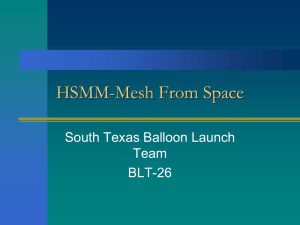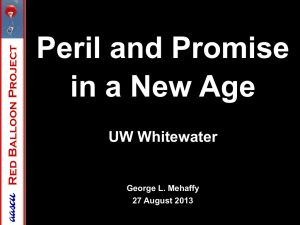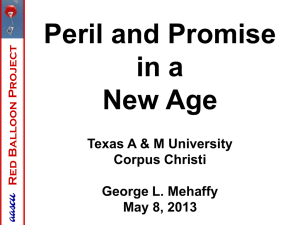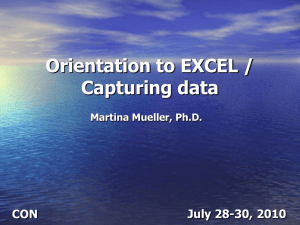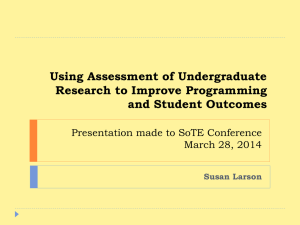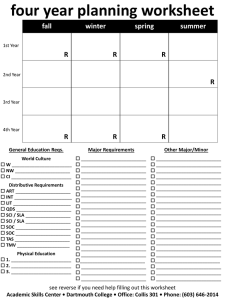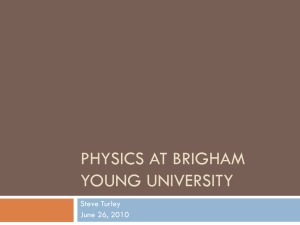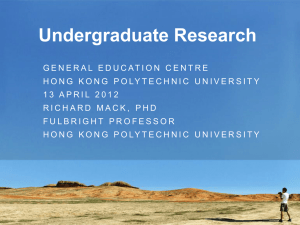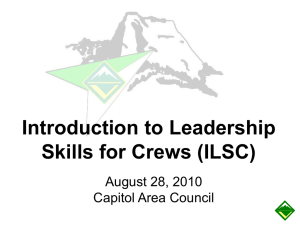Red Balloon Project by George Mehaffy
advertisement
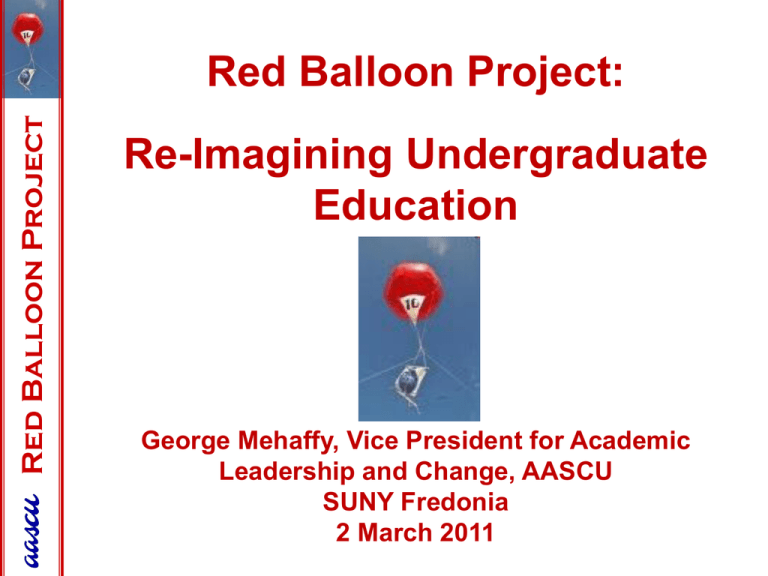
Red Balloon Project Red Balloon Project: Re-Imagining Undergraduate Education George Mehaffy, Vice President for Academic Leadership and Change, AASCU SUNY Fredonia 2 March 2011 Red Balloon Project February 2, 2011 Groundhog Day The trouble with weather forecasting is that it's right too often for us to ignore it and wrong too often for us to rely on it. Patrick Young Red Balloon Project We are confronting a period of massive change and great uncertainty Our institutions are challenged as never before Red Balloon Project New occasions teach new duties, time makes ancient good uncouth, they must upward still and onward, who would keep abreast of truth. James Russell Lowe Red Balloon Project We must act, or be acted upon Only together can we respond effectively Red Balloon Project The Problem Red Balloon Project Our University Model Was created in the 11th century To prepare our students Operates on a 19thstcentury for life in the 21 century agrarian calendar Red Balloon Project Our university model was designed for the elite. Now higher education must serve a very diverse mass market. 1. Our current model for funding public higher education is not sustainable 2. Our current model for delivering public higher education is not sustainable 3. Our current public higher education business models are not sustainable Red Balloon Project 1. Our current model for funding and delivering public higher education is not sustainable The way in which America finances public colleges and universities…is severely and irreparably broken. Darryl G. Greer and Michael W. Klein, “Fixing the Broken Financing Model.” Inside Higher Ed, October 4, 2010. 300% The unsustainable funding trends at public 4-year institutions, 1988-2008 250% Price/Cost gap 200% 150% Spending v. State approps 100% 50% 0% 1988 1990 1992 1994 Net tuition/FTE 1996 1998 2000 State Appropriations/FTE 2002 E&R/FTE 2004 2006 CPI Index Source: Delta Cost Project IPEDS database, 1987-2008, 22-year matched set. Notes: Percent change since 1988 based on unadjusted dollar amounts. From the Delta project. Courtesy Jane Wellman 2008 Red Balloon Project 2. Our university model, designed for the elite, has now been called upon to provide higher education to a mass market 177 million 310 million http://www.bls.gov/opub/ted/2010/ted_20100428.htm Red Balloon Project 3. Our current business models will not sustain our work Higher education is a set of cross-subsidies: graduate education subsidized by undergraduate; upper division subsidized by lower division Jane Wellman, Delta Project http://www.deltacostproject.org/ The Rising Cost of College, 1988-2008 (based on increases in current dollar amounts) 350% Cumulative growth since 1988 300% 250% Public Four-Year Private Four-Year 200% Public Two-Year Median Family Income CPI-U 150% Prescription Drugs Household Energy New Vehicle 100% 50% 0% 1988 1990 1992 1994 1996 1998 2000 2002 2004 2006 2008 Sources: College Board, “Trends in College Pricing, 2008”; Bureau of Labor Statistics, 2009, www.bls.gov ; U.S. Census, Current Population Study-ASEC, 2008. From the Delta Project. Courtesy Jane Wellman Red Balloon Project “…the choice for higher education during this critical juncture is “reinvention or extinction.” E. Gordon Gee Ohio State University Robert H. Atwell Lecture American Council on Education Annual Meeting, February 2009. http://www.acenet.edu/media/mp3s/AM09_Gee.mp3 Red Balloon Project 3 Key Propositions 1. Funding for public higher education will not return to previous levels. 2. Increasing calls for greater numbers of graduates 3. Technology changes everything Red Balloon Project FUNDING National Governors Association (NGA): “…state budgets will not be balanced until the latter part of the decade.” “Health, criminal justice, and the K-12 schools will consume an increasingly larger share of the state’s resources.” “Many states have structural deficits…” http://www.cbpp.org/cms/?fa=view&id=711 Red Balloon Project 44 states are reporting fiscal year 2012 shortfalls New York Times, January 23, 2011, p. 3. Red Balloon Project Greater Numbers of Graduates President Obama By 2020, America will once again have the highest proportion of college graduates in the world. http://www.whitehouse.gov/the_press_office/remarks-of-presidentbarack-obama-address-to-joint-session-of-congress/ Lumina Foundation “Big Goal” By 2025, 60% of adult Americans will have high quality degrees and certificates. http://www.luminafoundation.org/goal_2025/ Red Balloon Project Credit Hour Distribution and Average Instructional Costs Public-four Year Averages, 4-state cost study (SUNY, Florida, Ohio, Illinois) Lower Division % of all credits taken 36% % of total spending on instruction 23% Avg weighted cost/credit 1.00 Upper Division 48% 44% 1.42 Grad 1 12% 23% 2.88 Grad 2 4% 9% 4.00 100% 100% 1.55 SHEEO, 2010 Courtesy Jane Wellman 31.2 30 29.7 24.8 25 Percentage of Dropouts Red Balloon Project 35 Percentage of All Dropouts by Cumulative Months Enrolled, Beginning Postsecondary Students 2003-04 60% of attrition occurs in lower Division courses .. Where spending per student is lowest 20 15 11.3 10 5 2.8 0.2 0 1 to 12 13 to 24 25 to 36 37 to 48 49 to 60 61 to 72 Total Months Enrolled Before Leaving Higher Education (Out of 72 Possible) NCES, BPS, undergraduates only Courtesy Jane Wellman Red Balloon Project Technology Changes Everything Recent changes in technology: • Make it possible to communicate with more people than ever before • Enable learning any time, any place, any how • Facilitate personalization • Promote openness, which promotes sharing • Promote participation in content, knowledge, and news production • Enable collaboration across the world Brenda Gourley, EDUCAUSE Review, Vol. 45, no. 1 (January/February 2010): 30-41. Red Balloon Project Think about the impact of technology: On journalism… On the music business… On the book publishing/selling business… The Long Tail. Chris Anderson (Hyperion, 2006) Red Balloon Project Content Is Now Everywhere Academic Earth academicearth.org Connexions cnx.org OpenCourseWare Consortium ocwconsortium.org iTunes U http://www.apple.com/education/itunes-u/ YouTube http://www.youtube.com/education Red Balloon Project The new era of TECHNOLOGY will challenge our historic models of: 1. Teaching and Learning 2. Institutional Organization and Structure 3. Our concept of expertise Red Balloon Project 1. Teaching and Learning Technology Changes Instructional Design • From instruction to discovery • From individual to collaborative learning • From broadcast to interactive learning • From teacher-centric to student-centric Don Tapscott. Grown Up Digital. McGraw-Hill, 2009. Red Balloon Project 2. Institutional Organization and Structure Technology is creating opportunities for the unbundling or disaggregation of educational activities and processes, within a course, within a program, within an institution, and beyond. Red Balloon Project 3. The Concept of Expertise Study in the journal Nature comparing the accuracy of entries in two well-known on-line references: Encyclopedia Britannica Wikipedia Found that error rates were about 3 per entry for Encyclopedia, 4 per entry for Wikipedia http://www.nature.com/nature/journal/v438/n7070/full/438900a.html Red Balloon Project Encyclopedia Britannica Founded in 1768, on-line version started in 1994, the first internet encyclopedia. English print edition is a 32 volume set, 64,000 articles, 4,300 contributors, latest print edition 2005. The problem with a print edition • Article on Afghanistan is 12 pages long and has been updated in several places to reflect changes in 2002, but no mention of Hamid Karzai's election. • Article on George W. Bush ends with the November 2002 elections. • Article on Iraq ends in 2000 but users are referred to the Britannica Book of the Year for later developments. Red Balloon Project Wikipedia Edited by anyone, 7th most visited website in the world. 78 million readers in U.S., 365 million worldwide, each month. 250+ languages 3,514,326 articles in English, 14 million articles total. 22,711,389 pages Staff of 30, started 2001, not-for-profit organization Wikipedia’s Evolving Impact. Stuart West. TED2010 Red Balloon Project Information is now everywhere, on hand-held devices, available at our fingertips, 24 hours a day. Access to information has changed our relationship to one another, to entertainment, to health care, to every other part of our lives. Why won’t it change our relationship to education? Red Balloon Project It already has… Red Balloon Project Herpetological Conservation and Biology Created by a group of herpetologists— Founded in 2006, online-only, open-access, peer-reviewed journal with a budget of about $100 a year. 2006 - 6,000 unique visitors 2010 - 42,288 from 160 countries http://chronicle.com/article/Hot-Type-ScholarsCreate/126090/?sid=at&utm_source=at&utm_medium=en Red Balloon Project Vitek Tracz: Faculty of 1,000 Created “the Facebook of Science” to change the nature of peer review. Transform papers from one-shot events owned by publishers into evolving discussions among those researchers, authors, and readers. http://chronicle.com/article/Facebook-of-Science-Seeksto/126087/?sid=at&utm_source=at&utm_medium=en Red Balloon Project Cloud Computing To help reduce the number of dropouts in freshman biology courses, professors at the University at Buffalo have turned to the power of collaboration and cloud computing to build an online teaching tool designed to explain concepts better than a textbook can. The tool, called Pop!World, provides a visual way to map evolution. http://chronicle.com/blogs/wiredcampus/biology-professors-usecloud-computing-to-reachstudents/29330?sid=pm&utm_source=pm&utm_medium=en Red Balloon Project Professors Using Smart Phones - Apps 1. Taking attendance ($ 20,000) 2. Collecting Data 3. Reading Scholarly Articles 4. Recording Notes 5. Using Textbook Tools 6. Planning Lectures http://chronicle.com/article/College-20-6-TopSmartphone/125764/?sid=pm&utm_source=pm&utm_medium=en Red Balloon Project Researchers at Carnegie Mellon University have found that “crowdsourced” articles written piecemeal by dispersed writers stack up well against those drafted by one author. CrowdForge http://chronicle.com/blogs/wiredcampus/carnegiemellon-researchers-find-crowds-can-write-as-well-asindividuals/29440?sid=at&utm_source=at&utm_mediu m=en Red Balloon Project Sophia 1. Identify the best teachers for any concept 2. Put their instruction for that concept online 3. Students all over the world can use these “learning packets” free of charge http://chronicle.com/blogs/wiredcampus/social-teachingcompany-gets-buy-in-from-capellaeducation/29466?sid=at&utm_source=at&utm_medium=en Red Balloon Project Rio Salado College improved online-course completion rates from 50 percent to upward of 80 percent. Technology played a big role... • 24/7 student support • Detecting signals of classroom success and failure • Library services available online http://chronicle.com/blogs/wiredcampus/beating-the-not-invented-herementality/28849?sid=at&utm_source=at&utm_medium=en Red Balloon Project In this new Internet age, what is our job? • Designers - learning environments? • Facilitators of learning? • Aggregators of learning credits (super swirling)? • Assessors of learning outcomes? • Certifiers of degree completion? Red Balloon Project AASCU’s Red Balloon Project Red Balloon Project Defense Advanced Research Projects Agency Red Balloon Contest $ 40,000 Winning Team: MIT Post Doc, plus 4, plus 4,000 Learned about the contest on Tuesday, announced the team strategy on Thursday, contest began on Saturday Red Balloon Project Where DARPA Put Their Balloons Red Balloon Project How long did it take to find 10 randomly placed 8 foot high bright red weather balloons, suspended 30-50 feet above the ground, somewhere in the United States? Red Balloon Project 8 hours 52 minutes Red Balloon Project The Red Balloon Contest Is Both: A Metaphor And An Analogy Red Balloon Project The Red Balloon Contest is a Metaphor for the new ways that knowledge is now being: • Created • Aggregated • Disseminated Red Balloon Project The Red Balloon Contest Is an Analogy for the way that we might work together collaboratively to re- design undergraduate education Red Balloon Project Someone has to do something, and it’s just incredibly pathetic that it has to be us. Jerry Garcia Red Balloon Project Can We Create 21st Century Learning Environments On Our Campuses? Design Principles and Models 7 Principles High Impact Practices Chickering and Gamson Kuh Red Balloon Project Chickering and Gamson, 7 Principles 1. Encourages contact between students and faculty 2. Develops reciprocity and cooperation among students 3. Encourages active learning 4. Gives prompt feedback 5. Emphasizes time on task 6. Communicates high expectations 7. Respects diverse talents and ways of learning Seven Principles for Good Practice in Undergraduate Education. Arthur W. Chickering and Zelda F. Gamson, American Association for Higher Education Bulletin, March 1987 Red Balloon Project IMPLEMENTING THE SEVEN PRINCIPLES: Technology as Lever. Arthur W. Chickering and Stephen C. Ehrmann This article originally appeared in print as: Chickering, Arthur and Stephen C. Ehrmann (1996), "Implementing the Seven Principles: Technology as Lever,“ AAHE Bulletin, October, pp. 3-6. Red Balloon Project George Kuh High Impact Practices • First-year seminars and experiences • Common intellectual experiences • Learning communities • Writing-intensive courses • Collaborative assignments and projects • Undergraduate research • Diversity/global learning • Service learning, community-based learning • Internships • Capstone courses and projects George Kuh. High-Impact Educational Practices: What They Are, Who Has Access to Them, and Why They Matter. AAC&U, 2008. Red Balloon Project “We hold time constant and learning variable? Shouldn’t it be just the opposite?” Stephen Portch, Chancellor University System of Georgia “We individualize faculty practice (allow individual faculty members great latitude in course development and delivery) and standardize the student learning experience (treat all students in a course as if their learning needs, interests, and abilities were the same).” Carol Twigg NCAT Red Balloon Project The Project AASCU Will Serve As Coordinator We’ll use: Academic Affairs Summer and Winter Meeting Webcasts, Web Page, Blog, Wiki, Conference Calls, etc. Red Balloon Project AASCU will work with member institutions willing to engage in “Re-imagining Undergraduate Education.” Campuses will form discussion groups, action teams, or some other structure or set of structures. Red Balloon Project AASCU will link the local campus efforts with one another, and with a national group of project coordinators. AASCU will also create a repository of ideas, resources, program designs, etc. for campuses to use. Red Balloon Project Analogy: Supercomputer… It’s not a giant computer It’s actually a number of small computers all working together Red Balloon Project Can we, together, become a supercomputer for re-designing undergraduate education? Red Balloon Project Red Balloon Project Goals Lower Costs 1. Maximize cost-effectiveness (either hold costs constant while increasing the number of students involved, or reduce costs) 2. Make programs scalable (increase the number of students served while reducing per-student costs) Red Balloon Project Increase Learning Outcomes 1. Create more effective student engagement. Engagement is the key to greater learning outcomes 2. Produce greater learning outcomes documented by a rich array of instruments and assessment strategies Red Balloon Project Respond to the Challenge of a New Century 1. Focus on the development of 21st century skills to create 21st century learning and leadership outcomes 2. Rethink teaching, learning, and faculty roles Red Balloon Project A Focus on Course Redesign The Heart of the Matter Red Balloon Project Typical Current Course Models 1. Cottage Industry Model 2. Open University (UK) – University of Phoenix Model 3. Partnership Model (USC) 4. Individual Course Model 5. 21st Century Model Red Balloon Project 1. Cottage Industry Model Everyone designs his or her own course, from scratch, each semester. And no one learns anything about the most effective course content or most effective teaching practices… except that individual teacher, who learns only from his or her own experiences. Red Balloon Project 2. Open University of the UK University of Phoenix Model • Huge resources (money and people) put into course design • Taught by a large number of adjunct in a fairly similar way • Evaluation of learning outcomes conducted by another unit • Huge scale involved (U of Phoenix 450,000 students; Kaplan 1,000,000 worldwide) Red Balloon Project 3. Partnership Model (USC) Venture capitalist partners with a public or not-for-profit university to deliver a specific course or program. • USC and John Katzman: MAT • Lamar University and Randy Best: MA in Education – reduced cost and time to completion The last frontier, when outsourcing finally penetrates the academic center. Red Balloon Project 4. Individual Course Offerings StraighterLine: • offers courses for $ 99 • entire freshman year for $ 999 Blackboard and K-12, Inc • Selling online courses to community colleges Red Balloon Project Here’s One Problem Carol Twigg 25 general introductory courses generate 25% of undergraduate enrollment at the baccalaureate level Red Balloon Project Jane Wellman Higher education has massive crosssubsidies • Graduate education subsidized by undergraduate education • Upper division undergraduate education subsidized by lower division Red Balloon Project So what happens if new course models, delivered by others, hollow out the undergraduate course-taking? What happens if students start “superswirling? What happens to our institutions? Red Balloon Project The models I’ve described are either: 1. Too costly (cottage industry approach) 2. Too mechanistic (Open University) 3. Too Darwinian (venture capital models) 4. Too fragmented (course by course model) Red Balloon Project Is there a new 21st model that works for American public higher education? Could we, for example, create a new model of course development, using national/state/system/or collaborators and local elements? Could we create courses with powerful nonlocal content developed collaboratively, yet a model where local institutional faculty are essential? Red Balloon Project “The future is here. It's just not evenly distributed.” William Gibson American-Canadian science fiction writer. Red Balloon Project Carol Twigg - Course Redesign Project Six Models for Transformation 1. Supplemental Model 2. Replacement Model 3. Emporium Model 4. Fully On-line Model 5. Buffet Model 6. Linked Workshop Model National Center for Academic Transformation. www.thencat.org/PlanRes/R2R_ModCrsRed.htm http://www.educationsector.org/usr_doc/NCAT-Report_RELEASE.pdf Red Balloon Project In Twigg’s first cohort of 30 redesigned large courses, • 20 of the 30 courses showed learning gains (the others showed no significant differences) • Average savings of 40% • Increased course completion and retention rates • Improved students attitudes about the subject matter and course design Red Balloon Project Next Generation Learning Challenges (NGLC) Gates and the Hewlett Foundations Increasing college readiness and completion through applied technology. • Providing investment capital • Collecting and sharing evidence of what works • Fostering a community of innovators and adopters Red Balloon Project 1. Open Core Courseware: free worldclass, interactive learning materials available to students and faculty in highdemand, low-success courses 2. Blended Learning: minimize time spent in the classroom – and to take advantage of rich online learning when not in class. Red Balloon Project 3. Deeper Learning: Using social media, games, blogging, video sharing and virtual worlds to increase student engagement and result in deeper learning? 4. Learner Analytics: What if we could predict which students were most likely to fail a course or drop out? What if we knew how each student learned best? Red Balloon Project The Red Balloon NGLC Project • Nine (9) individual AASCU institutions • Three (3) state-wide efforts (Minnesota, Alabama, Missouri) with 11 AASCU institutions • AASCU • University of Central Florida Blended courses for lower division gatekeeper courses, mostly English and mathematics. Red Balloon Project U.S. Department of Education Study Evaluation of Evidence-Based Practices in Online Learning: Meta-Analysis and Review of Online Learning Studies September 2010 http://www2.ed.gov/rschstat/eval/tech/evide nce-based-practices/finalreport.pdf Red Balloon Project Findings 1. Students in online classes performed modestly better that traditional instruction. 2. Blended was the most powerful design. Combining face-to-face with online was better than either mode alone. 3. Effect size was larger when faculty were directly involved. 4. Effect size was larger when curriculum materials and instructional strategies varied. Red Balloon Project Blended Learning Courses that combine fact-to-face classroom instruction with online learning and reduced classroom contact hours (reduced seat time) • Shift from faculty-centered to studentcentered • Increased faculty-student, student-student, student-content, and student-resources interaction • Integrated formative and summative assessment mechanisms Charles Dziuban, Joel Hartman, Patsy Moskal. Blended Learning. EDUCAUSE. 2004 http://net.educause.edu/ir/library/pdf/ERB0407.pdf Red Balloon Project Data Analytics Data analytics is shorthand for the method of warehousing, organizing, and interpreting the massive amounts of data accrued by online learning platforms and student information systems … … in hopes of learning more about what makes students successful… … and by giving instructors (and the platforms themselves) the chance to adjust to improve learning outcomes. http://www.insidehighered.com/news/2010/11/09/completion Red Balloon Project Typical 3 hour course F to F 7.5 hours a week of faculty time Web New Faculty Opportunities F to F 1. Web Design 2. New Materials F to F F to F F to F 3. Data Analytics Research 4. Scholarship of Teaching and Learning 5. Assisting Students Red Balloon Project Advantages: 1. Better Designed Courses 2. Better Use of Diverse Human Talents 3. Robust Data Collection and Analysis 4. Faculty Professional Development 5. Increased Focus on Student Learning 6. Collaboration with Colleagues Red Balloon Project Here’s a similar idea: State of Washington: Community and Technical Colleges 81 highest enrollment courses Course materials capped at $ 30 per course, open to all Chronicle, January 9, 2011 http://chronicle.com/article/State-of-Washington-to-Offer/125887/ Red Balloon Project Two things, I think, will be at the heart of any substantive change: 1. A focus on learning outcomes 2. The nature of faculty work Red Balloon Project The Increasing Focus on Learning Outcomes Are we approaching the Barr and Tagg moment? When colleges and universities are designed as learning institutions, instead of teaching institutions? From Teaching to Learning: A New Paradigm for Undergraduate Education,” Change, Robert Barr and John Tagg, 1995. Red Balloon Project Faculty Work Rather than reduce faculty roles, I think this new era will expand faculty opportunities: • • • • • Designing learning environments Working with students in new ways Assessing learning outcomes Collaborating with others Engaging in the scholarship of teaching and learning Red Balloon Project What’s the right metaphor for the new faculty role? Gatekeeper of Knowledge Sage on the stage? Guide on the side? Navigator in a dramatically more complex environment? “The quality of the selected content and the quality of the learning experience and its outcome are consequences of the intervention, not the withdrawal, of the guiding hand of the teacher.” Brenda Gourley Red Balloon Project Faculty historically have been designers and delivers of individual courses (and content). Could they be designers instead of learning environments? Could some of those learning environments be environments without faculty? Red Balloon Project Yet this cannot be about course design alone. Course design has to be linked to system change across the institution. If you only change a few courses, you will not change the university. So for us in the Red Balloon Project, course design is at the center of a series of even larger institutional changes. Red Balloon Project Can We “Re-Imagine Undergraduate Education?” 1. New Models for Institutional Organization 2. New Models for Enrollment Management 3. New Models for Faculty Engagement 4. New Models for Curriculum Design 5. New Models for Course Design 6. New Models for Instructional Design Red Balloon Project In this new era, I think it comes down to this simple proposition: We fix ourselves or we will be fixed by others. There are hundreds of examples of politicians, public policy, and the public losing patience with higher education: its cost, its lack of attention to outcomes; and its apparent unwillingness to try to change or improve. Red Balloon Project We ought to be up to the task of figuring out what it is that our students know by the end of four years at college that they did not know at the beginning. Stanley N. Katz. Academe Online, September – October 2010 Red Balloon Project “…if even a small portion of the ingenuity and persistence which are now being expended on research of the usual type in American colleges and universities could be deflected . . . toward research into the results of their own teaching, the improvement in the general standards of collegiate instruction might be considerable” American Association of University Professors. 1933. Report of the committee on college and university teaching. AAUP Bulletin 19 (5, section 2): 7–122. Red Balloon Project What could you be doing? Create a Collaborative Vision of the Future Promote Innovation Incentivize Progress Measure Success Avoid “hardening of the categories” Red Balloon Project America's economy is caught up in a "race between innovation and calcification--between the power of new ideas to lower costs and boost quality, and the power of entrenched interests to protect their habits and incomes." Matt Miller, Washington Post, September 22, 2010 Red Balloon Project Recommended Reading DIY_U. Anaya Kamenetz Academically Adrift R. Arum & J. Roksa The Wisdom of Crowds James Surowiecki The Long Tail Chris Anderson Grown Up Digital Don Tapscott Red Balloon Project The Pony Express A Cautionary Tale Red Balloon Project Red Balloon Project The Pony Express A Cautionary Tale St. Joseph, MO to Sacramento, CA 1,900 miles Stations set up every 10 miles (as far as a horse can gallop); Riders changed every 60 to 100 miles. Reduced letter delivery from 24 to 10 days Red Balloon Project Started: April 3, 1860 Ended: October 26, 1861 19 months later Why? The completion of the transcontinental telegraph Red Balloon Project Is our Pony Express moment coming? “It’s March 2011 California’s new governor calls a morning news conference to make a stunning announcement: The Apollo Group’s University of Phoenix will pay $2.3 billion to buy the California State University system.” William Tierney, Educational Policy Institute Guest Commentator January 29, 2010 http://www.educationalpolicy.org/publications/etw/us/commentary/etwus com_100129.html Red Balloon Project “It is not the strongest of the species that survives, nor the most intelligent. It is the one that is the most adaptable to change.” Attributed (apparently incorrectly) to Charles Darwin Red Balloon Project
